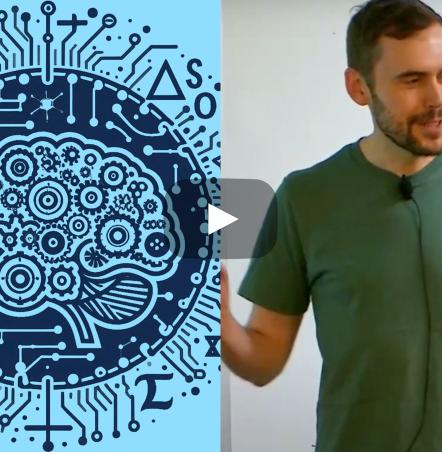Research Vignette: Optimization Against Adversarial Uncertainty

by James R. Lee, University of Washington
The rise of machine learning in recent decades has generated a renewed interest in online decision-making, where algorithms are equipped only with partial information about the world, and must take actions in the face of uncertainty about the future. There are various ways to analyze how much the presence of uncertainty degrades optimization. Two of the most general models (competitive analysis and multi-arm bandits) are "probability free" (aka "worst-case," or "adversarial"), in the sense that one can measure the performance of algorithms without making distributional assumptions on the input.
Competitive analysis
One such model goes by the name of competitive analysis, and has been studied in theoretical CS since the 1970s. Imagine, for instance, that one maintains a binary search tree (BST) with key-value pairs at the nodes. At every point in time, a key is requested, and the corresponding value is looked up via binary search. Along the search path, the algorithm is allowed to modify the tree using standard tree rotation operations.
The cost of such an algorithm is the average number of binary search steps per key-lookup over a long sequence of requests. To minimize the cost, it is beneficial for the algorithm to dynamically rebalance the tree so that frequently-requested keys are near the root. Sleator and Tarjan had this model in mind when they invented the Splay Tree data structure. Their (still unproven) Dynamic Optimality Conjecture asserts that, for every sequence of key requests, the number of operations used by the Splay Tree is within a constant factor of the number of operations used by any binary search tree, even an offline algorithm that is allowed to see the entire sequence of key requests in advance. (This is a very strong requirement! We make no assumption on the structure of the request sequence, and have to compare our performance to an algorithm that sees the entire request sequence up front.)
In the language of competitive analysis, the conjecture states that the Splay Tree algorithm is "competitive." In general, an \(\alpha\)-competitive online algorithm is one whose total cost on every input sequence is within an \(\alpha\) factor of the cost incurred by the optimal offline algorithm that sees the whole input sequence in advance.
Multi-arm bandits
Another compelling model arising in online learning is the multi-armed bandit problem. Here, an agent has a set \(\mathcal{A}\) of feasible actions. At time \(t=1,2,3,\ldots\), the agent plays an action \(a_t \in \mathcal{A}\), and only then the cost of that action is revealed. Imagine, for instance, choosing an advertisement \(a_t \in \mathcal{A}\) to present to a user, and then learning afterward the probability it led to a sale. The goal of an algorithm in this model is to achieve a total cost (often called the loss) that is not too much worse than the best fixed action in hindsight. The gap between the two is called the regret.
At first blush, it may seem that these two models (multi-arm bandits and competitive analysis) are quite different. But their relationship rests on a common theme in machine learning: The intimate connection between stability and generalization. A competitive binary search tree algorithm aspires to be stable in the sense that the search tree changes little between lookups because the requested key is often near the root. A low-regret advertiser aspires for her decisions to generalize in the sense that her past observations about users are predictive of their future actions. (One can consult a more in depth look at this connection in the context of Metrical Task Systems.)
Hedging and entropic regularization
A fundamental feature of algorithms designed in both models is hedging, i.e., making decisions now that protect against the cost of uncertainty in future inputs. In the bandit model, where one only learns the cost associated to the action played, hedging involves exploring the action space (the cost protected against here is opportunity cost). In competitive analysis, one can think of hedging as maintaining a state that avoids exploitation by an adversary. For instance, if there are 10 keys that are very frequently requested in a BST, hedging might involve a preference for a configuration in which all 10 keys are within distance 100 of the root, rather than a configuration in which 9 keys are within distance 3 and the 10th key is at distance 1000. This might be preferable even if those 9 keys are requested twice as often as the 10th.
In these settings, hedging is a tradeoff between cost (or utility) and entropy. In modern play of no-limit Texas hold 'em, this tradeoff is now explicit in the vernacular: Professional players talk of "balancing their range." For instance, it generally makes sense to bet with strong hands, and even to bet more as a hand gets stronger. But a player has to weigh this against their loss in entropy (from the perspective of an observer who does not know their hole cards): If I only go all-in before the flop with aces, my opponent will be able to play optimally against me whenever that occurs.
The idea of adding an entropic regularizer to the cost function has played a central (and rather explicit) role in online learning. The possible application of these ideas to competitive analysis was already suggested in work of Blum and Burch (2000) and more recently in a paper conceived at Berkeley by Abernethy, Bartlett, Buchbinder, and Stanton (2010). Those early attempts, while prescient, were not able to yield better general approaches for the classical problems in online algorithms.
But a collaboration seeded at the Simons Institute, and spanning from the Algorithmic Spectral Graph Theory program (Fall 2014) to the Continuous and Discrete Optimization program three years later was key in developing a theory of entropic regularization strong enough to attack some of the long-standing open problems in the field.
The randomized \(k\)-server conjecture
The \(k\)-server problem has been referred to as the "holy grail" of online algorithms, largely because of the central role it has played in the development of the field. Fix an integer \(k \geq 1\) and let \((X,d)\) denote a metric space. The input is a sequence \(\left\langle \rho_1,\rho_2, \ldots \right\rangle\) of requests \(\rho_t \in X\) that arrive online. The algorithm maintain a configuration of \(k\) servers at points of \(X\), and at time \(t=1,2,\ldots\), must move one of the servers to \(\rho_t\) to service the request. The cost incurred is the total server movement of the algorithm (in the metric \(d\)).
Koutsoupias and Papadimitriou famously established that the deterministic Work Function Algorithm is \(2k-1\) competitive. It has long been conjectured that randomized online algorithms should be capable of achieving a \((\log k)^{O(1)}\) competitive ratio (a strong version of the conjecture asserts that the competitive ratio is \(\Theta(\log k)\) for every metric space on more than \(k\) points). Over the course of a decade, primal-dual algorithms were the weapon of choice, culminating in a result of Bansal, Buchbinder, Mądry, and Naor that established a \(\mathrm{poly}(\log n)\)-competitive algorithm for the case when the underlying metric space has \(n\) points.
From Berkeley, to Seattle, to Cambridge, and back
During the reunion workshop for the ASGT program, I spoke about joint work that Prasad Raghavendra, David Steurer, and I had completed a year earlier establishing lower bounds on the size of semidefinite programming relaxations. A major theme in that work is the use of quantum entropy maximization. After my talk extolling the virtues of entropy maximizers, Aleksander Mądry (MIT) suggested that recent work on weighted paging (a special case of the \(k\)-server problem) seemed to match the narrative.
I returned to UW and taught a course on entropy optimality; Sébastien Bubeck (Microsoft Research) sat in on the lectures, and we began discussing the theory of mirror descent and its recent applications in online learning. One thing that became clear early on is that the classical exponential weights approach is too conservative to be competitive for \(k\)-server and related problems. While exponential weights is very effective in the bandit setting, there one generally competes against the optimal fixed strategy.
A solution to this problem (for the special case of weighted paging) lies in the paper of Bansal, Buchbinder, and Naor, where the authors consider an algorithm that can be interpreted in the following way: Run exponential weights, but never let the algorithm become too confident about its server placement. If the algorithm asserts "I am 99.9% sure there should be a server here," we cap this confidence at 95% (more formally, at \(1-1/2k\)). One can consult these lecture notes where this is referred to as the "exploration shift."
Since the work of Bartal (1996), it has been understood that solving \(k\)-server on hierarchically separated tree (HST) metrics is a fundamental first step in designing an algorithm for general metric spaces. Problematically, even with the above understanding for weighted paging, the HST case is far more daunting because one cannot write down the dynamics of the algorithm explicitly. This is where a general theory of mirror descent becomes crucial, though the correct notion of multiscale entropy (suitable for hedging simultaneously at many scales) requires a detailed understanding of the associated polytope.
Fortunately, Aleksander recruited an ambitious young graduate student named Michael Cohen, and they understood well the structure of the allocation polytope underlying previous work on HSTs. At the same time, Yin Tat Lee had joined us in Seattle (as a postdoc at MSR, and then as faculty at UW), and we continued to study the dark side of the exploration shift: When the confidence of the algorithm is artificially reduced, it becomes more willing to move servers, and one has to control the corresponding increase in movement cost. (The resulting analytic mess is enough to make "inverse Hessian" start to sound like foul language.)
With a little help from 0.1 friends
A rather ingenious observation of Michael is that the cost of the exploration shift can be controlled almost effortlessly if we just have a little extra help: Instead of \(k\) servers, \(k+0.1\) servers. (This requires passing to a fractional relaxation of the \(k\)-server problem, which we had already done implicitly five paragraphs and 10+ years ago.) Moreover, on HSTs one can show that \(k+0.1\) fractional servers can always be simulated by \(k\) fractional servers while increasing the movement costs by only a constant factor.
Sébastien, Michael, Yin Tat, Aleksander, and I were all long-term participants in the Optimization program (Aleksander was an organizer) this past fall. Our work culminated in an \(O((\log k)^2)\)-competitive randomized algorithm for the \(k\)-server problem on HSTs: \(k\)-server via multiscale entropic regularization. In followup work, I show how this can be utilized to obtain a \(\mathrm{poly}(\log k)\)-competitive algorithm for any metric space.
Tragically, Michael passed away unexpectedly during the program. The memorial symposium held in his honor offers a glimpse of the brilliance and impact of his short time with us.
Additional references
- The book Competitive Analysis by Borodin and El-Yaniv.
- Algorithms and Uncertainty program (Fall 2016) at the Simons Institute.
- The course Competitive analysis via convex optimization (Spring 2018), taught at UW, jointly with Sébastien Bubeck.





